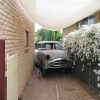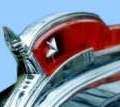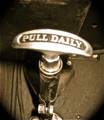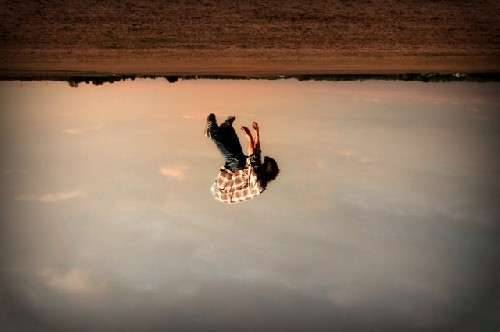|
Re: Larry's 1951 Club Sedan Project
|
||||
|---|---|---|---|---|
|
Home away from home

|
Cleaning and Painting Turret Interior.
This was something I did a while ago, I guess it's worthwhile posting something about it . . . . . The turret had some minor pitting towards the front and around the edges, which I think was due mainly to condensation. Metal surface under the fibre sound-proofing matting was in perfect condition. (No moisture is going to condense under the mat!). There was some surface rust under the original black sound-deadener coating, but luckily it was not necessary to replace any metal. The worst place (heavy surface rust) was above the windscreen. Condensation had run forward and sat in the semi-closed section above the screen. Hard to get into that area but I used every shape of home-made tool to scrape and sand away what was there, and after many hours it was 100% clean and rust-free. Treated it with Deoxidine and then black POR-15 which I had to apply with a 'bent' small brush. Got it right into all the metal joins and had it seeping down between the turret skin and pillars / screen frame, right where water gets. It was an extremely messy job, grinding away the surface rust, bituminous coating and glue etc off the turret. Even though the car had been grit-blasted the large flat surfaces (bonnet, turret, doors, rear quarter panels) had not been cleaned in that manner, as I was aware of the risk of heat and pressure distortion. The sound deadener coating was best removed with a fibre clean-up wheel, then many wipes with kerosene got the remainder off. Then I 'polished' the metal with a stripper disc or three. Appears the 24th Series Packards like mine were not painted on the inside of the turret, just given a thin coating of sound-deadener, with the fibrous matting square placed over bare (untreated) metal. Some surface rust and minor pitting formed under the coating during the many years. I wanted to make sure there would never be a chance of more rust forming there, so gave the turret two coats of POR15 Grey after neutralizing the surface with Metal Ready. Quite a task, spraying the M-Ready without getting it all over me. Later I'll glue on a square of new (modern) matting, for sound deadening. This will be larger than the original fibrous mat (hemp? - I didn't smoke any of it - honest!). That'll remove the need for me spraying black sound deadener as was done originally. Some restoreres don't like the idea of POR-15 being used in certain places, but I'll swear by the stuff. It adheres beautifully to bare metal, so no priming and top-coating is needed. Rust cannot form under it and there's no chance of it separating with the extreme heat that will affect the turret. Also a small amount covers a big area . . . and you can brush it on and get a very smooth finish. In terms of time saved not having to prime/ topcoat, it's not expensive. It can be over-coated with virtually any other finish, if necessary. Later when all final finishes have been applied I intend to give the internal girders and their channels a small squirt of Dynax S50 rust preventative ( Dynax S50 info . . . . ) as I'm convinced there can still be a build-up of condensation, which could run down into the metal seams to some extent. Very pleased this part of the resto is now completed as it was a messy and awkward job, hard on the arms and shoulders trying to scrape and grind away the old coating and surface rust. Plus I have a sense of relief that there was no major structural rust found. Stripping the internal surface under way   Worst surface rust was towards the front, above the screen . . .  Black POR-15 seeping thru' staple holes and turret seams    The girders - grey POR-15 used extensively to get right into the areas where condensation lurks  Two coats right across turret interior, including where the new sound-proof matting will go  Check the gloss! Pity it's on the inside  Overall view, with girder areas primed for a later top-coat to finish it off  Masked off and ready to top-coat the girder area 
Posted on: 2011/6/19 4:08
|
|||
|
1951 Packard Club Sedan | [url=ht
|
||||
|
||||
|
Re: Larry's 1951 Club Sedan Project
|
||||
|---|---|---|---|---|
|
Home away from home

|
Attach file:  (10.84 KB) (10.84 KB)
Posted on: 2011/6/19 7:16
|
|||
|
The story of ZIS-110, ZIS-115, ZIL-111 & Chaika GAZ-13 on www.guscha.de
|
||||
|
||||
|
Re: Larry's 1951 Club Sedan Project
|
||||
|---|---|---|---|---|
|
Home away from home

|
Ha! Very good Guscha.
(?? How did you do that??) 
Posted on: 2011/6/19 9:03
|
|||
|
1951 Packard Club Sedan | [url=ht
|
||||
|
||||
|
Re: Larry's 1951 Club Sedan Project
|
||||
|---|---|---|---|---|
|
Home away from home

|
Larry, it is just a small legerdemain. What you see has been written, screenshot, moved to Microsoft Paint to turn it on its head and thereafter attached as pic.
<iframe width="425" height="349" src="http://www.youtube.com/embed/QWkurH-MEtA" frameborder="0" allowfullscreen></iframe>
Posted on: 2011/6/19 12:24
|
|||
|
The story of ZIS-110, ZIS-115, ZIL-111 & Chaika GAZ-13 on www.guscha.de
|
||||
|
||||
|
Re: Larry's 1951 Club Sedan Project
|
||||
|---|---|---|---|---|
|
Home away from home

|
Thanks Guscha (- I noticed it was a jpeg).
Also enjoyed the clip of Diana. Have been a fan since I was in my teens (especially the early stuff with The Supremes). PS: Spare a thought for us down here, desperately clinging to the earth!
Posted on: 2011/6/21 7:49
|
|||
|
1951 Packard Club Sedan | [url=ht
|
||||
|
||||
|
Re: Larry's 1951 Club Sedan Project
|
||||
|---|---|---|---|---|
|
Home away from home

|
Larry, so when you trip...
Posted on: 2011/6/21 8:39
|
|||
|
||||
|
Re: Larry's 1951 Club Sedan Project
|
||||
|---|---|---|---|---|
|
Home away from home

|
Restoring Underside of Dash / Firewall & Box Sections Below A-Pillars
It's been some months since I posted on my Blog. Have been very occupied with ill health of a family member and other family matters. So I have only done a day here and a day there on the car, so not much achieved at all for a long while. Now I'm really looking forward to getting started again.. The few days have added up to a little progress, so I'll cover that work in a few posts. Some pics of cleaning the under-dash / firewall area, which was not bad for rust. The grit blasting had not been done well under there so it was a few hours on my back, looking up, and using grit paper, die grinder with wire brushes and home-made scrapers etc to get all the old sealant etc off. Removing all the grit is also a time-consuming job, as there always seems to be a bit of it somewhere despite blasting at every conceivable angle with air and vacuuming etc. The box sections (A-pillar) have also mainly escaped the rust, with only surface rust to remove (except for one section which was replaced when the metal work was done). So after cleaning (mainly with rotary brushes) I treated with Phosphoric, dried it all with a heat gun and gave it a few coats of primer. Here are some pics - before and after - not necessarily in order.     After treating with Phosphoric acid . . .   Getting the acid neutralizer in there with a pump bottle made it an easy job      And the special 'tool' (fencing wire!) to scrape away old sealant. 
Posted on: 2011/10/21 8:12
|
|||
|
1951 Packard Club Sedan | [url=ht
|
||||
|
||||
|
Re: Larry's 1951 Club Sedan Project
|
||||
|---|---|---|---|---|
|
Home away from home

|
Reconditioning the Water Pump
I set out to recondition the water pumps as per the Workshop Manual guidelines. Pressed out the shaft / bearing / seal from pump body no problems. My home-made press capacity is only 6 tonnes at present (could take 20 tonnes I think) but 6 was enough to easily press the parts. Nice change from the fiddly cosmetic panel-work I have been doing on the body. Enjoyable doing a bit of 'mechanicking' rather than filling / sanding etc. The two pumps I've got have different seals in them (- one has no shaft or bearing) so it was a bit of a mystery as to which seal I should use. Sourced a new shaft and bearing locally (bit of a surprise that was!) but it looked like I would have to get seals from the States. After a few emails it turned out no-one in the US wanted to sell me just the seals. I'd have to buy either a kit (shaft / bearing / seal / gaskets) or a reconditioned pump and ship it over, which was quite expensive (of course) because they're not light-weight. Kanter apparently doesn't stock the kits anymore, you have to buy a recon pump from them, which is NBG for Oz customers because shipping the core back costs an arm and a leg. The local mob (ABC Bearings) in Sydney sent me a couple of seals which were close but the problem was going to be the pressure the seals would be working under, because the ABC 'substitute' seals mounted differently. They sit higher, which would make them exert heaps of pressure on the mating surface . . . . I didn't want to modify the pump so decided to modify the seal by grinding the lip off and thereby getting the seal to sit right down in the pump housing where it would not be pressing hard on the impeller surface (eventually leading to problems). See the diagram below I've done showing how the original seal is mounted. Distance 'A' has to be right and that cannot easily be achieved with the non-standard seal that I was provided with unless the seal has lip removed so seal can sit down lower and thereby increase gap 'A'. It only took moments to grind off the lip of the new seals. Now it was going to be a challenge pressing the seal into the pump body without distorting them! Most of the strength and rigidity is in the lip. . . . . . . which was no longer there. I greased the housing and seal and proceeded to tap the seal into the recess using a cup-head bolt placed onto the centre of the seal. (With the seal lip no longer there it was necessary to use the centre tunnel of the seal for whacking the seal into place). Luckily the thin metal of the seal didn't distort too badly (- it's extremely thin) and the seal eventually responded by moving nicely into it's correct position in the bottom of the pump housing 'well'. I immediately rushed out and bought a lottery ticket . . . (just kidding. The day I win the lottery Hell will freeze over and pigs will fly). Had to cut the shaft to required length, it was case hardened but a standard hacksaw blade cut it easily. Made the gaskets and now all that remains is to assemble the two pumps. One will be a 'spare' because the bearing is 'dry' (no grease in it) and I don't think I can re-grease it. It will be OK as a spare because the bearing runs smooth and has little wear even with no grease in it. Would probably get a few thousand miles out of it if it was ever needed.  445 complete pump before pressing shaft out. Feeler gauge is to check distance of impeller from pump body, before disassembly  448 Cover - not too badly corroded!  449 Cover to impeller clearance - not much to spare here!  452 The home-made press  457 Making gaskets  459 Mating surface of im[peller before dressing with oilstones. Very rough initially  467 After dressing with coarse and then fine oilstones  472 The shafts and other components. New shaft has to be cut to size  475 Old seal in situ and new one showing different format  476 Side view comparing seal design and depths  477 Comparing depth with a different seal from a second pump  478 Lip on the new seal - about to be ground off so the new seal can be seated right down in the pump body  484 Special (?!) seal placement tool- a dome-head bolt did the trick  479 New seal tapped into place, using domed bolt head placed onto the centre 'tunnel' of the seal.  480 New seal protrudes from body about 1/4 inch which is approx the right distance  483 Diagram showing distance 'A' - the pump body lip to base of the Impeller, which is approx ? inch. Pressure on the mating surfaces is influenced by depth of the seal. When substituting a different seal design this needs to be considered.
Posted on: 2011/11/1 7:12
|
|||
|
1951 Packard Club Sedan | [url=ht
|
||||
|
||||
|
Re: Larry's 1951 Club Sedan Project
|
||||
|---|---|---|---|---|
|
Just can't stay away
|
Quote:
the postwar pumps from Kanters are now brand new with no return of the old core required. I've seen the new Kanter pumps. They are from China. Although they will bolt up the casting does look different than an original. Also was told they fail much before an original pump would have. Just passing along what I heard. I would go with a rebuilt original if possible.
Posted on: 2011/11/1 14:43
|
|||
|
||||










